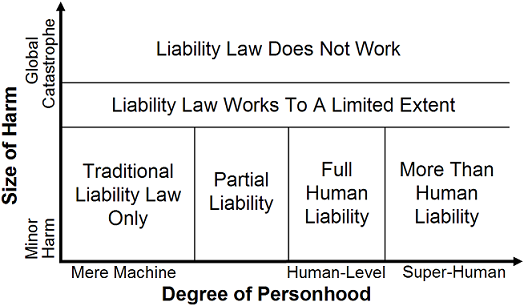
The paper's classification scheme for the applicability of liability law to various sizes of harms caused by various types of robots.
Liability law can handle current and near-future robots, but could be challenged by advanced future robots that merit legal personhood or pose global catastrophic risk.
Trevor N. White and Seth D. Baum, 2017. Liability law for present and future robotics technology. In Patrick Lin, Keith Abney, and Ryan Jenkins (editors), Robot Ethics 2.0, Oxford: Oxford University Press, pages 66-79.
Pre-print: Not available. Please see the edited collection's page at Oxford University Press.
Abstract:
Advances in robotics technology are causing major changes in manufacturing, transportation, medicine, and numerous other sectors. While many of these changes are beneficial, some will inevitably lead to harms. Who should be liable when a robot causes harm? This paper addresses how liability law can and should account for robots, including robots that exist today and that could potentially be built in the future. Current and near-future robots pose no significant challenge for liability law: existing liability law or minor variations thereof can readily handle them. A greater challenge will arise if it becomes possible to build robots that merit legal personhood and thus can be held liable, as well as if future robots could cause major global catastrophe.

The paper's classification scheme for the applicability of liability law to various sizes of harms caused by various types of robots.
Created 2 Oct 2017 * Updated 2 Oct 2017